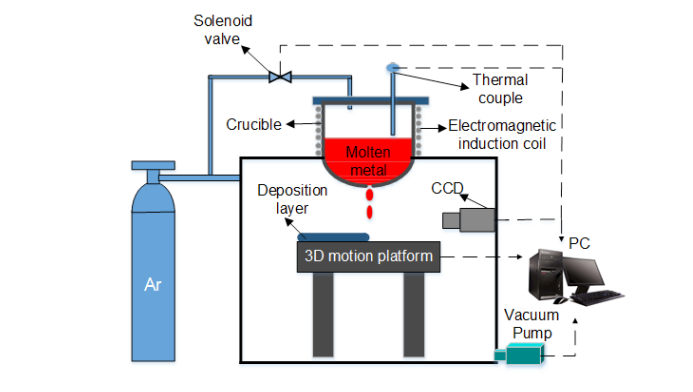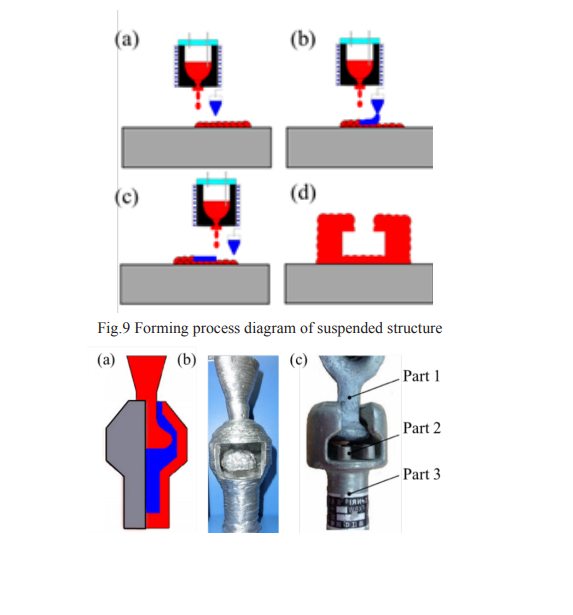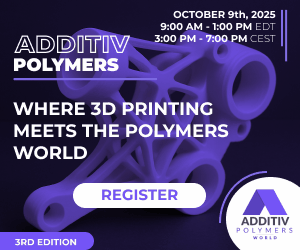In ‘The Additive Manufacturing Process of Electric Power Fittings Fabricated by Metal Droplet Deposition,’ authors Zhengying Wei, HaiHua Wu, and Guangxi Zhao explore more about AM techniques that could prove to be better, faster, and more affordable for manufacturing electric power fittings.
This research focuses on making components with electromagnetic induction, in comparison to more traditional techniques of both casting and forging. Hoping to eliminate more cost-prohibitive methods, the Chinese authors explore ways to manufacture the fittings on-site, using metal droplet deposition. Previous efforts and studies have produced components with inferior properties like surface quality.
Droplet deposition consists of the following:
- Pneumatic system – producing droplets on demand, comprised of a controller, solenoid valve, crucible, heating furnace, and nitrogen gas resource.
- Motion control system – forms workpieces by controlling the 3D platform according to data, made up of the program multiple axes controller, 3D movement platform, and deposition substrate.
- Forming process monitoring system – observes deposition process, made up of CCD camera, and image acquisition card.
- Inert environment control system – prevents metal from oxidizing and is made up of the glove box and the gas circulating device.
Molten aluminum droplets were printed on a horizontal Al alloy substrate, leaving the researchers to analyze droplet parameters like size, displacement, and temperature.
“The results indicated that the internal structure is dense, and the mechanical properties were good,” stated the researchers.
During the experiment, a thin-walled workpiece was redesigned, along with a ball head ring workpiece that was created. Supporting materials were added to prevent collapse, with a variety of materials such as gypsum powder, sand, ceramic, and resin combined to test the support properties.
Microstructure analysis indicated that droplet diameter was maintained at 100 μm for the most stable droplets. Ultimately, the scientist’s experiments were able to prove that the electric power fittings they created would satisfy all requirements for users engaging in this type of process. Substrate temperature, moving speed, and the deposition process were all evaluated during the experiment, and they comprehensively assessed the fitting workpieces and the structural stability and composition of the support materials that were required.
“Dimensional accuracy and microstructure analysis of the workpieces were carried out. No obvious overlap trace (such as overlap line and cracks) was observed, and the internal microstructure is equiaxial crystal. Density is measured by drainage method. The average density of droplet deposition components is 99.51%, which is much higher than the cast raw material,” concluded the researchers.
Metal 3D printing is being explored in so many different ways today as scientists explore methods like electron beam welding, droplet control, how droplets interact, and more. What do you think of this news? Let us know your thoughts! Join the discussion of this and other 3D printing topics at 3DPrintBoard.com.
[Source / Images: ‘The Additive Manufacturing Process of Electric Power Fittings Fabricated by Metal Droplet Deposition’]
Subscribe to Our Email Newsletter
Stay up-to-date on all the latest news from the 3D printing industry and receive information and offers from third party vendors.
Print Services
Upload your 3D Models and get them printed quickly and efficiently.
You May Also Like
Does the Fed Rate Cut Mean Anything for Manufacturers?
About a year ago, the Federal Reserve issued the “jumbo” rate cut, reducing interest rates for the first time since hiking them to their highest levels in decades, a process...
MacLean-Fogg & Fraunhofer ILT Make 156 Kg 3D Printed Toyota Tooling Insert
Fastener & tooling firm MacLean-Fogg Company and Fraunhofer ILT have created a 156 kg conformally cooled die casting insert, made out of the firm’s own L-40 tool steel powder. This...
3DPOD 272: Kevin Kassekert, VulcanForms CEO
Kevin Kassekert has deep experience building factories for Tesla and has worked in the semiconductor industry. He now helms VulcanForms and is looking to scale their high-yield Laser Powder Bed...
3D Printing News Briefs, September 20, 2025: Standards, Floor Slabs, Wastewater Treatment, & More
In this weekend’s 3D Printing News Briefs, we’ll start with standards news from ASTM. Then, we’ll move on to a new 3D printable alloy from QuesTek Innovations, and Autodesk Research...




































